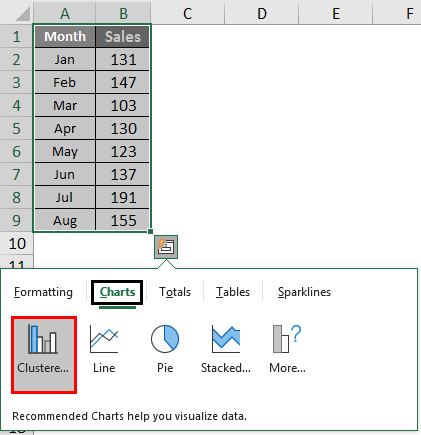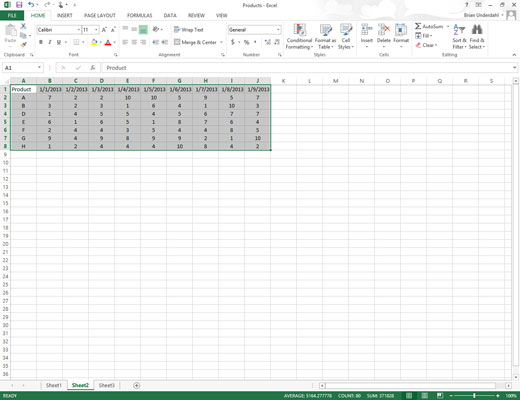


- HOW TO USE QUICK ANALYSIS TOOL IN EXCEL 2013 FULL
- HOW TO USE QUICK ANALYSIS TOOL IN EXCEL 2013 SERIES
- HOW TO USE QUICK ANALYSIS TOOL IN EXCEL 2013 DOWNLOAD
However, you cannot open a worksheet from SkyDrive in Excel 2013 on your local machine if someone else is currently working in the same worksheet. In Excel 2013 you can share and work collaboratively on files with others via SkyDrive using the Excel WebApp, and multiple people can work on the same file at the same time. While it’s useful to do this, you will face problems when two people try to change the same item at the same time. Working with other people on shared files in real time is a double-edged sword.
HOW TO USE QUICK ANALYSIS TOOL IN EXCEL 2013 DOWNLOAD
You can view and download it, but can’t change it. Try to work on a worksheet that someone else is editing? You’ll be warned that it’s locked. The Power View tab on the Ribbon toolbar displays report format options, such as Theme and text formats, as well View options for Field List and Filters Area panels that you can use to filter and sort your data. You can add a title and then filter the data and organize it to display the way you like. Then a Power View sheet will be added to your workbook, and the analysis report will be created. The first time you use it, the feature installs automatically. To see it at work, select your data and choose Insert, Power View. Incorporated within Excel, it’s now accessible to anyone. Power View is typically used for analyzing large quantities of data brought in from external data sources-just the sort of tool that big business might use. The Power View add-in, available for previous versions of Excel, is now integrated inside Excel 2013. All you need do is to select the table that shows what you want to see, click OK,and the PivotTable is automatically drawn for you.Įxcel 2013 now integrates Power View for beefy analysis and reporting.
HOW TO USE QUICK ANALYSIS TOOL IN EXCEL 2013 SERIES
A dialog appears showing a series of PivotTables with explanations of what they show. To use it, select your data, including headings, and choose Insert, Recommended PivotTables. For the first time, though, if you can click a mouse key, then you can create a meaningful Pivot Table, thanks to the new Recommended PivotTables. Pivot Tables are a powerful tool for analyzing and answering questions about your data, but they’re not easy for new users to create. Answer questions instantly with Pivot Tables PivotTables just became ridiculously simple to create. This feature speeds up the process of formatting, charting and writing formulas. Next, click the option you like to apply it to your data. Click any option, and a series of selectable choices appear preview those choices by mousing over them. To use it, select the data to analyze, and the Quick Analysis icon appears in the bottom-right corner of the selected data.Ĭlick that icon, and a dialog appears showing a range of tools for analyzing the data, such as Formatting, Charts, Totals, Tables and Sparklines. The new Quick Analysis tool can help both new and experienced users find options for working with selected data. Quick Analysis offers formatting, totals and charts for analyzing your data. Click Chart Elements to add or remove elements, such as axis titles and legends click Chart Styles to change the style and color of your chart or click Chart Filtersto view filtered data using a live preview. Click any of these buttons-Chart Elements, Chart Styles or Chart Filters-to reveal additional chart formatting options. In addition, a set of icons appears outside the top right edge of a chart when it is selected. While you could have always done this with formulas, now Flash Fill ensures anyone can do it very quickly and easily. You can use the same process to extract last names, to join first and last names, to extract months, days or years from dates and even extract values from cells. The first names of everyone in the list will be entered into that that column immediately.
HOW TO USE QUICK ANALYSIS TOOL IN EXCEL 2013 FULL
In a blank column adjacent to the one that contains full names, you simply type the first name and then click the Home tab, and select Fill, Flash Fill. One such problem is extracting a person’s first name from a column of full names. It solves some common problems that currently require cumbersome workarounds to achieve. Its predictive data entry can detect patterns and extract and enter data that follows a recognizable pattern.

The most whiz-bang new feature is the Flash Fill tool. Want to split first and last names into two columns? Look to the new Flash Fill feature. There’s also access to your SkyDrive account, and the option to set up additional SkyDrive or SharePoint accounts. You can pin worksheets to this list or click Computer to access recently accessed locations (any of which you can pin permanently here, too). The Open tab now gives you access to recently accessed workbooks, making it a combination of the Open and Recent tabs from Excel 2010.


 0 kommentar(er)
0 kommentar(er)
